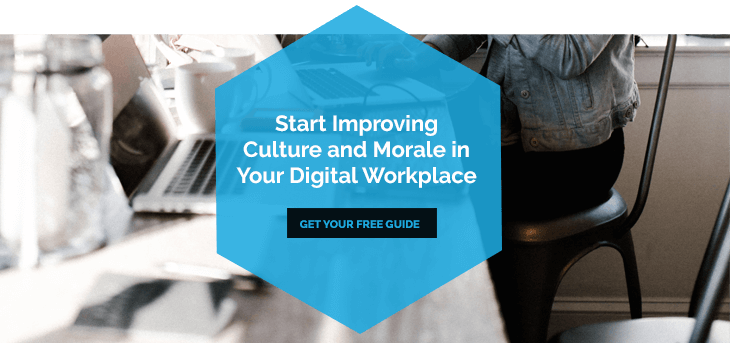Updated: 7th February 2019
The way we work is constantly evolving and over the past decade, the workplace has seen numerous changes which have helped to foster a culture within the enterprise that empowers employees.
Digital workplaces have made internal and external communications much more agile, with employees being able to participate in wikis, blogs, social intranets and a host of collaborative projects. These features can be particularly useful for organisations looking to boost employee experience during a crisis.
A book written 9 years ago, The 2020 Workplace by Jeanne C. Meister and Karie Willyerd confirms that the workplace revolution has been taking place for some time. The book shows plenty of insight into how we will work in the future, with much of what the authors predicted already being evident now.

Social has changed everything
In general, many of the changes we’re seeing take place have been heavily influenced by social media. By this, I mean all aspects of social, from blogging to video and the emergence of the social intranet. But what effect, if any, does this have on internal culture and morale?
According to studies engaged employees work harder, are often willing to take on extra responsibilities and are a positive influence on other employees. Unengaged employees basically serve time and do no more and possibly less than required.”
Employees that are actively disengaged tend to be disruptive and a bad influence on others. However, for those companies with a high level engagement, benefits include a higher rate of productivity and a lower staff turnover.

Creating engagement
To do so means to encourage a workplace culture that allows for a massive amount of employee involvement and there is plenty of evidence to support this. These days, it’s not just the job of the HR department though, but of IT too. This is because technology is a great enabler when it comes to engagement, thus boosting productivity and morale.
Morale is boosted also by employees feeling that they are valued, with gratitude being expressed and given by superiors proving important. Trust amongst colleagues is also hugely important to morale and this is why team work and collaboration in the enterprise should be encouraged.
Flexibility in the workplace is also important to increasing morale, as studies have shown that it produces less absenteeism, higher engagement and productivity. Those employees that are given the opportunity for flexible working feel much more trusted and valued than those who don’t.
According to Forbes, many enterprises of today view flexibility as a strategy, rather than an outright employee perk, as they recognise its value.
Trust and control
Those employees that have flexible working plans in place work better due to a sense of control over their own lives and careers. By giving workers options, employers are telling them that they are valued and this is reflected in the bigger investment that an employee will make in work and the company.
In IT, the ‘talent shortage’ has been a point of discussion for some time now, but The 2020 Workplace points out that this is set to bleed into other industries in the years to come. Employers will have to work harder to attract top talent and those that offer flexible working and a good working culture with healthy morale will be the ones that win out.
What is an engaged employee
According to the research company, Gallup, engaged employees are committed, love their job and care about what happens to the company they work for. This ultimately leads to higher levels of performance, and as Gallup explains, "better customer engagement, higher productivity, better retention, fewer accidents, and 21% higher profitability". Whilst in years gone by the power has been firmly in the hands of the employer, this is no longer the case and companies have to work harder to gain and retain top talent.
This is not something that’s related to money either, it’s down to how happy and challenged an employee is and how healthy the workplace culture is. Engagement to some extent has to occur naturally too; there can be no demanding that employees engage by managers, no looking over their shoulder to check what workers are doing, this is highly counterproductive.
Leadership and management
This means that for some companies, it will be necessary to look differently at how they tackle leadership and what types of leaders are in the enterprise. According to Ivey Business Journal, there are ten key ‘C’ words that managers should bear in mind when approaching how they deal with employees, these are:
- Connect – good relationships between managers and employees are vital to engagement. Those workers that clash with management as they feel undervalued will never work at their top capacity for the company.
- Career – Workers want to feel like they have the chance to advance their career and want challenging and meaningful work that can help them achieve this. It’s up to the leader not only to find work that challenges employs, but to also instil the confidence in the employee that they can achieve. This process is ongoing and begins during the employee onboarding stage.
- Clarity – Leaders need to have vision and this must be communicated to the employee, who wants to know that he’s working for a progressive company and wants to fully understand its goals.
- Convey – Good leaders put in place processes and procedures that allow workers to achieve goals. It’s not enough to provide feedback, there must be some facilitation behind driving employees to master tasks and then constructive and encouraging feedback should be given.
- Congratulate – Too many companies are quick to criticize when things go wrong and unwilling to give praise where it’s due. This fosters a negative working culture as everyone needs encouragement and is the sign of a bad leader.
- Contribute – Employees that understand how their work is contributing to the overall company strategy perform better than those who don’t. This means that managers have to communicate why a workers job is important and show them proven results.
- Control – workers like to have control over their own lives, as mentioned earlier on, and this can be achieved by flexible working and consulting them over issues that are relevant to their job. The ability for an employee to voice his ideas and opinions is important to this feeling of control.
- Collaborate – this is something that is seeing a huge rise in popularity within all departments of the enterprise. Team work strengthens relationships with both leaders and colleagues, leading to a happier, more engaged and productive workplace.
- Credibility – People want to be proud of what they do and they want to know that they are working for an ethical and high-performing company.
- Confidence – In order to be proud of the company, an employee has to have confidence is his leaders and the company itself. Scandal, be it of a personal or corporate nature, really tend to damage employee (and consumer) confidence.
How do your digital workplace tools stack up?
In order to increase engagement amongst employees, an effective digital workplace strategy needs to be considered. In a nutshell, the digital workplace simply refers to the tools and technologies that enable employees to get their job done efficiently and engage effectively.
There are a range of digital workplace tools an organisation can and should utilise:
Fortunately these tools and many more are offered as part of good intranet features which can be adapted to include various social and collaborative features and those that encourage the worker to be actively involved in the company, rather than just thinking of it as 9-5 drudgery. This in turn creates a thriving digital workplace, resulting in a happier, more collaborative and engaged workforce.
Bearing all of this in mind, in order for companies to create a good working culture that engages employees and boosts morale, they must pay attention to the wants and needs of the employee and use enabling technology to facilitate this.
